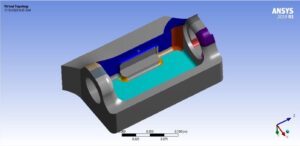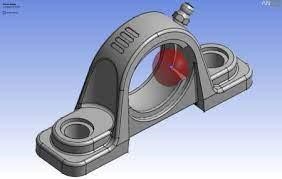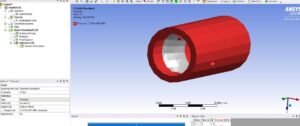Why Meshing Fails in ANSYS: Common Causes and Solutions
Meshing can fail in ANSYS for several reasons, including geometry issues, element quality problems, improper mesh settings, and computational limitations.
Here are some common reasons why meshing may fail in ANSYS:
- 1. Geometry issues refer to problems or anomalies present in the geometry that can hinder the meshing process or cause inaccuracies in the analysis. The issues need to be addressed before attempting to mesh the geometry are:
Gaps and overlaps: Gaps occur when there are missing or disconnected surfaces in the geometry, while overlaps happen when surfaces intersect or occupy the same space. Gaps and overlaps prevent the creation of a watertight geometry, which is essential for proper meshing. These issues can result from errors in the CAD model or import process. To resolve them, you need to repair the geometry by closing gaps or removing overlaps using CAD software or Ansys’s geometry tools.
Self-intersections: Self-intersections occur when surfaces or bodies intersect or penetrate each other within the geometry. Self-intersections can lead to invalid meshing as the meshing algorithm cannot handle overlapping or intersecting surfaces. It is necessary to identify and resolve self-intersections by modifying or repairing the geometry.
Small features or sharp edges: Very small features or sharp edges in the geometry can pose challenges for meshing algorithms. Elements with extremely small sizes can cause meshing failures or lead to poor element quality. In such cases, it may be necessary to simplify or smooth out the geometry by removing unnecessary small details or rounding sharp edges.
Thin or sliver surfaces: Thin or sliver surfaces are extremely thin regions in the geometry that can cause meshing difficulties. These surfaces may have a significantly different scale compared to the rest of the model, leading to meshing issues and poor element quality. It is advisable to address thin or sliver surfaces by thickening or removing them if they do not significantly impact the analysis.
Complex or poorly defined geometries: Complex geometries with intricate details, sharp corners, or irregular shapes can be challenging to mesh accurately. Poorly defined geometries, lacking proper feature recognition or modeling, can also lead to difficulties in creating a high-quality mesh. In such cases, simplifying or partitioning the geometry and utilizing meshing techniques suitable for complex geometries can help overcome the issues.


To address geometry issues:
-
- Review and repair the CAD model before importing it into Ansys.
- Use the geometry repair tools provided in Ansys to fix gaps, overlaps, or self-intersections.
- Simplify the geometry by removing unnecessary small features or rounding sharp edges.
- Identify and address thin or sliver surfaces by thickening or removing them if appropriate.
- Consider partitioning or simplifying complex geometries to facilitate meshing.
- Collaborate with CAD experts or consult ANSYS documentation and forums for specific guidance on resolving geometry-related issues.
By addressing geometry issues, you can ensure a clean and well-defined geometry that facilitates successful meshing and accurate analysis in Ansys.
2. Element quality refers to the measure of the shape and quality of individual elements in a mesh generated in Ansys. High-quality elements are desirable as they ensure accurate and reliable results in finite element analysis. Poor element quality can lead to numerical inaccuracies, convergence difficulties, and unreliable simulation outcomes.
Element quality metrics are used to assess the quality of elements within a mesh. Some common element quality metrics include aspect ratio, skewness, orthogonality, and Jacobian. These metrics provide quantitative measures of the element shape and distortion.
Evaluate element quality using various tools and methods as mentioned below:
Visualization: It provides visualization tools to examine the element quality visually. You can inspect the mesh and identify elements that exhibit poor shapes, such as distorted or highly stretched elements. Visual inspection allows you to identify problematic areas and focus on improving the mesh quality in those regions.
Element quality criteria: Allows you to define specific element quality criteria or thresholds. You can set limits for metrics such as aspect ratio, skewness, and Jacobian to identify elements that fall outside the desired range. These criteria help in identifying elements that may adversely affect the accuracy of the analysis.
Element quality checks: Ansys includes built-in checks and diagnostics to evaluate element quality. These checks identify problematic elements and provide diagnostic information to help pinpoint issues. For example, the software can flag elements with excessively high skewness or elements with very small aspect ratios.
Mesh refinement: If poor element quality is identified in specific areas, you can refine the mesh in those regions. Mesh refinement involves reducing element sizes or employing adaptive meshing techniques to capture more detailed features or resolve distorted elements. Refining the mesh helps to improve element quality and ensures accurate representation of the geometry.
By assessing and improving element quality, you can enhance the accuracy and reliability of the finite element analysis conducted. It is essential to maintain a balance between computational efficiency and mesh quality, ensuring that the mesh is fine enough to capture critical features while avoiding excessive computational costs.
Inadequate mesh settings : lead to meshing failures or poor-quality meshes, which can adversely affect the accuracy and reliability of the analysis results. It is important to set appropriate meshing parameters to ensure a well-behaved and suitable mesh for the intended analysis. Here are some common inadequate mesh settings and their implications.
Element size: The element size determines the level of mesh detail and accuracy. Inadequate element size settings can result in either a mesh that is too coarse, failing to capture important features and variations in the geometry, or a mesh that is too fine, leading to excessive computational costs. It is crucial to select an appropriate element size based on the geometry, analysis requirements, and the desired balance between accuracy and computational efficiency.
Growth rate: The growth rate specifies how the element size increases or decreases as you move away from specified regions or boundaries. Inadequate growth rate settings can lead to abrupt transitions in element sizes or a lack of smooth gradation in the mesh. It is important to choose a suitable growth rate that ensures a smooth transition in element sizes while avoiding sudden changes that may affect the mesh quality or convergence of the analysis.
Element type: Different element types, such as tetrahedral, hexahedral, or triangular elements, have different advantages and disadvantages. Inadequate element type selection can result in inaccurate representation of the geometry or inefficient use of computational resources. It is important to choose the appropriate element type based on the geometry’s characteristics, analysis requirements, and the desired trade-off between accuracy and computational efficiency.
Boundary conditions and interfaces: Inadequate specification of boundary conditions and interfaces can lead to problems during meshing. For example, improperly defined contact interfaces or incorrectly applied boundary conditions can cause meshing errors or difficulties in generating a suitable mesh. It is crucial to ensure that the boundary conditions and interfaces are correctly defined and compatible with the meshing process.
Mesh control: In Ansys, you can apply mesh controls to specific regions or features of the geometry to refine or coarsen the mesh. Inadequate mesh control settings, such as insufficient refinement in critical regions or excessive refinement in non-critical areas, can lead to inaccurate results or unnecessary computational overhead. Careful consideration should be given to applying mesh controls appropriately to capture the desired level of detail in the mesh.

To address inadequate mesh settings:
-
- Understand the requirements of the analysis and the characteristics of the geometry to determine appropriate mesh settings.
- Adjust the element size, growth rate, and element type based on the specific needs of the analysis and geometry complexity.
- Apply mesh controls selectively to refine or coarsen the mesh in regions of interest.
- Regularly review and validate the mesh quality using visualization tools and quality metrics.
- Iterate and refine the mesh settings as needed based on convergence and accuracy requirements.
By setting appropriate meshing parameters, you can generate a mesh that strikes a balance between accuracy and computational efficiency, leading to reliable analysis results.
3. Computational limitations can impact the performance and feasibility of simulations in Ansys. These limitations arise due to the computational resources required to handle large and complex models or simulations with high levels of detail.
Here are some common computational limitations:
Memory limitations: Simulating large models or models with a high level of detail can require a significant amount of memory. If the available memory is insufficient, it can lead to memory errors or crashes during the simulation or meshing process. Insufficient memory may also cause slow performance or the inability to handle complex simulations. Increasing the available memory or optimizing the model to reduce memory requirements can help overcome this limitation.
Processing power limitations: Complex simulations, such as those involving transient analyses or multiphysics phenomena, can be computationally intensive and require significant processing power. If the available processing power is inadequate, the simulation may take a long time to complete or may not converge. Consider utilizing high-performance computing resources or parallel processing capabilities to overcome processing power limitations.
Disk space limitations: Ansys generates various files during the simulation process, including input files, result files, and temporary files. Simulations with large models or long durations can generate substantial amounts of data that require sufficient disk space for storage. Insufficient disk space can prevent the successful completion of simulations or result in data loss. Ensuring adequate disk space is available or archiving and managing simulation data properly can help mitigate this limitation.
Meshing limitations: Meshing large and complex models can be computationally demanding. Generating a high-quality mesh with sufficient resolution may require significant computational resources. Inadequate computational resources may lead to meshing failures, excessively long meshing times, or compromised mesh quality. Adjusting meshing settings, utilizing parallel processing, or employing meshing techniques suitable for complex geometries can help address meshing limitations.
Solver limitations: Ansys relies on solvers to perform the actual simulation calculations. Different solvers have different capabilities and limitations. Some solvers may have difficulty handling certain types of simulations or specific physical phenomena. It is important to understand the limitations of the selected solver and choose an appropriate solver that is capable of handling the desired analysis.

To address computational limitations are:
-
- Optimize the model geometry to reduce computational requirements while preserving the essential features for analysis.
- Use adaptive meshing techniques to focus computational resources on critical areas and reduce unnecessary mesh refinement.
- Utilize high-performance computing (HPC) resources, such as clusters or parallel processing, to distribute the computational workload and accelerate simulations.
- Allocate sufficient memory and disk space to accommodate the simulation requirements.
- Consider using alternative solvers or solver settings that are better suited for specific analysis types or physical phenomena.
Consult ANSYS documentation and resources, as well as seek assistance from ANSYS support, to understand and address specific computational limitations.
By understanding and managing computational limitations, you can optimize the performance and feasibility of simulations, enabling more accurate and efficient analysis.
4. Meshing constraints
Meshing constraints are utilized to impose specific requirements or limitations on the mesh generation process. These constraints ensure that the resulting mesh adheres to certain criteria or guidelines.
Here are several commonly used meshing constraints:
Element size constraints: Element size constraints enable you to define minimum and maximum element sizes in different regions of the geometry. By specifying these constraints, you can ensure that the mesh has the desired resolution. For instance, you can set smaller element sizes in areas with intricate geometric details or regions of interest that necessitate finer mesh resolution.
Mesh sizing controls: Mesh sizing controls provide more fine-grained control over element sizes by allowing you to define sizing controls on specific entities such as edges, faces, or bodies. This allows you to target particular features or regions of the geometry for more accurate meshing. By applying sizing controls, you can refine or coarsen the mesh in specific areas based on the analysis or design requirements.
Mesh growth controls: Mesh growth controls determine how the element size changes as you move away from specified regions or boundaries. By adjusting these controls, you can control the transition of element sizes and ensure a smooth gradation in the mesh. This is beneficial when you need a gradual increase or decrease in element size as you move away from specific features.
Face sizing controls: Face sizing controls enforce specific element sizes on individual faces of the geometry. This constraint is useful when you want consistent mesh resolution on particular surfaces or when dealing with surfaces that require a specific element size for accuracy or convergence.
Element aspect ratio constraints: Aspect ratio constraints allow you to limit the distortion or elongation of elements. By setting a maximum aspect ratio, you can prevent the creation of highly distorted elements that could adversely impact the analysis accuracy. This constraint helps maintain element quality and improves the reliability of the simulation results.
Orthogonality constraints: Orthogonality constraints control the angles between adjacent elements. By setting limits on element orthogonality, you ensure that the mesh contains elements with acceptable angles between faces. This enhances the accuracy and stability of the analysis.
These meshing constraints can be applied using various tools and settings within Ansys, such as the Meshing Application, Mesh Method settings, or the Mesh Details view. By effectively utilizing these constraints, you can generate a mesh that meets specific requirements, accurately captures important features, and yields reliable results for your analysis.
It’s important to note that the specific reasons for meshing failures can vary depending on the geometry, analysis type, and software version being used. When encountering meshing issues, it is advisable to refer to relevant resources such as Ansys documentation, online forums, or seek assistance from the ANSYS support team. Additionally, organizations like Artem Academy offer comprehensive courses and informative blog posts that cover meshing techniques in Ansys, providing valuable insights and guidance to overcome common challenges.
Meshing failures can arise from a variety of factors, including geometry issues, complex geometries, inadequate mesh settings, mesh quality criteria, and resource limitations. By addressing these causes and implementing appropriate solutions, engineers can overcome meshing challenges and obtain high-quality meshes for accurate and reliable simulations. Taking the time to understand the underlying causes of meshing failures and leveraging the capabilities of Ansys can significantly enhance the efficiency and effectiveness of the simulation workflow.

Summary in a nut shell
Geometry issues: Meshing requires a clean and watertight geometry representation. If the geometry contains gaps, overlaps, self-intersections, or other geometric anomalies, the meshing algorithm may fail to create a valid mesh. It is important to ensure that the geometry is properly prepared, and any geometric issues are resolved before attempting to mesh.
Element quality: Meshing algorithms strive to generate high-quality elements that accurately represent the geometry and maintain good aspect ratios. However, in complex or poorly defined geometries, it can be challenging to create elements with good quality. Meshing may fail if the algorithm cannot create elements that meet the specified quality criteria, such as aspect ratio, skewness, or orthogonality.
Inadequate mesh settings: Improper meshing settings or parameters can lead to meshing failures. If the element size, growth rate, or other meshing parameters are set incorrectly, the meshing algorithm may struggle to generate a valid mesh. It is essential to understand the meshing settings and ensure they are appropriate for the geometry and analysis requirements.
Computational limitations: Meshing large and complex models can be computationally demanding. Insufficient computational resources, such as memory or processing power, can cause meshing to fail. If the model is too large or the available resources are limited, the meshing process may encounter memory errors or take an excessively long time to complete.
Meshing constraints: In some cases, certain constraints or requirements specified by the user may prevent successful meshing. For example, if there are overly stringent mesh size or element quality constraints that cannot be met due to the complexity of the geometry, the meshing process may fail.
To address meshing failures, it is helpful to perform the following steps:
-
- Review and fix any geometry issues before attempting to mesh.
- Adjust meshing parameters, such as element size and growth rate, to better suit the geometry and analysis requirements.
- Consider using adaptive meshing techniques that automatically refine the mesh in critical regions.
- Simplify or partition complex geometries to make meshing more manageable.
- Increase computational resources, if possible, to handle large and complex models.
If all else fails, consult ANSYS documentation, user forums, or seek support from ANSYS technical support for guidance on resolving specific meshing issues.
It’s important to note that the specific reasons for meshing failures can vary depending on the geometry, analysis type, and software version being used.




